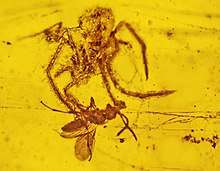Evolution of spiders
The evolution of spiders has been going on for at least 380 million years, since the first true spiders (thin-waisted arachnids) evolved from crab-like chelicerate ancestors. More than 45,000 extant species have been described, organised taxonomically in 3,958 genera and 114 families.[1] There may be more than 120,000 species.[1] Fossil diversity rates make up a larger proportion than extant diversity would suggest with 1,593 arachnid species described out of 1,952 recognized chelicerates.[2] Both extant and fossil species are described yearly by researchers in the field (see External links for most recent list of fossil species). Major developments in spider evolution include the development of spinnerets and silk secretion.

Early spider-like arachnids
Among the oldest known land arthropods are Trigonotarbids, members of an extinct order of spider-like arachnids.[3]
Trigonotarbids share many superficial characteristics with spiders, including a terrestrial lifestyle, respiration through book lungs, and walking on eight legs, with a pair of leg-like pedipalps near the mouth and mouth parts. Arguments still remain open as to whether they possessed the ability to create silk. This had been a popular thought for quite some time, until an unpublished fossil was described with distinct microtubercles on its hind legs, akin to those used by spiders to direct and manipulate their silk.
Trigonotarbids are not true spiders, and most Trigonotarbid species have no living descendants today. One lineage, however, led eventually to the earliest tetrapulmonates, which then evolved into spiders, whip scorpions, and close relatives.
Emergence of true spiders

At one stage the oldest fossil spider was believed to be Attercopus which lived 380 million years ago during the Devonian. Attercopus was placed as the sister-taxon to all living spiders, but has now been reinterpreted as a member of a separate, extinct order Uraraneida which could produce silk, but did not have true spinnerets.
The oldest true spiders date to the Carboniferous age, or about 300 million years ago. Most of these early segmented fossil spiders from the Coal Measures of Europe and North America probably belonged to the Mesothelae, or something very similar, a group of primitive spiders with the spinnerets placed underneath the middle of the abdomen, rather than at the end as in modern spiders. They were probably ground-dwelling predators, living in the giant clubmoss and fern forests of the mid-late Palaeozoic, where they were presumably predators of other primitive arthropods. Silk may have been used simply as a protective covering for the eggs, a lining for a retreat hole, and later perhaps for simple ground sheet web and trapdoor construction.
As plant and insect life diversified so also did the spider's use of silk. Spiders with spinnerets at the end of the abdomen (Mygalomorphae and Araneomorphae) appeared more than 250 million years ago, presumably promoting the development of more elaborate sheet and maze webs for prey capture both on ground and foliage, as well as the development of the safety dragline. The oldest mygalomorph, Rosamygale, was described from the Triassic of France and belongs to the modern family Hexathelidae. Megarachne servinei from the Permo-Carboniferous was once thought to be a giant mygalomorph spider and, with its body length of 1 foot (34 cm) and leg span of above 20 inches (50 cm), the largest known spider ever to have lived on Earth, but subsequent examination by an expert revealed that it was actually a relatively small sea scorpion.
By the Jurassic, the sophisticated aerial webs of the orb-weaver spiders had already developed to take advantage of the rapidly diversifying groups of insects. A spider web preserved in amber, thought to be 110 million years old, shows evidence of a perfect "orb" web, the most famous, circular kind one thinks of when imagining spider webs. An examination of the drift of those genes thought to be used to produce the web-spinning behavior suggests that orb spinning was in an advanced state as many as 136 million years ago. One of these, the araneid Mongolarachne jurassica, from about 165 million years ago, recorded from Daohuogo, Inner Mongolia in China, is the largest known fossil of a spider.
The 110-million-year-old amber-preserved web is also the oldest to show trapped insects, containing a beetle, a mite, a wasp's leg, and a fly.[4] The ability to weave orb webs is thought to have been "lost", and sometimes even re-evolved or evolved separately, in different breeds of spiders since its first appearance.
See also
- Spider taxonomy
- Insect evolution
References
- Garrison, Nicole L.; Rodriguez, Juanita; Agnarsson, Ingi; Coddington, Jonathan A.; Griswold, Charles E.; Hamilton, Christopher A.; Hedin, Marshal; Kocot, Kevin M.; Ledford, Joel M.; Bond, Jason E. (2016). "Spider phylogenomics: untangling the Spider Tree of Life". PeerJ. 4: e1719. doi:10.7717/peerj.1719. ISSN 2167-8359. PMC 4768681. PMID 26925338.
- Jason A. Dunlop; et al. (2008), "How many species of fossil arachnids are there?", The Journal of Arachnology, 36 (2): 267–272, doi:10.1636/ch07-89.1
- Garwood, Russell J.; Edgecombe, Gregory D. (September 2011). "Early Terrestrial Animals, Evolution, and Uncertainty". Evolution: Education and Outreach. 4 (3): 489–501. doi:10.1007/s12052-011-0357-y. ISSN 1936-6426.
- "LiveScience.com - Oldest Known Spider Web Discovered in Amber". Retrieved June 25, 2006.
- Brunetta, Leslie; Craig, Catherine L. (2010). Spider silk : evolution and 400 million years of spinning, waiting, snagging, and mating. New Haven: Yale University Press. ISBN 978-0-300-14922-7.
- Penney, D. (2008). Dominican Amber Spiders: a comparative neontological approach to identification faunistics ecology and biogeography. Manchester: Siri Scientific Press. ISBN 978-0-9558636-0-8.
- Penney, D.; Selden P.A. (2011). Fossil Spiders: the evolutionary history of a mega-diverse order. Manchester: Siri Scientific Press. ISBN 978-0-9558636-5-3.
External links
- Picture of spider fossil
- Dunlop, J. A., Penney, D. & Jekel, D. (2016). A summary list of fossil spiders and their relatives. World Spider Catalog. Natural History Museum Bern, online at http://wsc.nmbe.ch, version 16.5.

